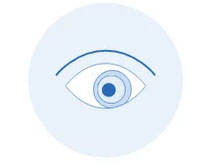
Squint surgery, also known as strabismus surgery or eye muscle surgery, is a procedure performed to correct misalignment of the eyes. Strabismus occurs when the muscles that control eye movement are imbalanced, leading to one or both eyes turning inwards (esotropia), outwards (exotropia), upwards (hypertropia), or downwards (hypotropia). Here are key points about squint surgery:
Indications:
- Squint surgery is indicated when non-surgical interventions, such as eyeglasses, vision therapy, or eye patching, are unable to correct the misalignment of the eyes.
- The goal is to improve eye alignment and restore binocular vision.
Types of Strabismus Surgery:
- Recession: Weakening of an eye muscle by moving its attachment towards the back of the eye.
- Resection: Strengthening of an eye muscle by removing a portion of the muscle.
- Adjustable Sutures: Sutures are temporarily left long during surgery, and final adjustments are made after the patient is awake.
Adjustable Sutures:
- Adjustable sutures allow for fine-tuning of the eye muscle position after the patient has fully recovered from anesthesia.
- This technique is particularly useful for achieving precise alignment and optimizing visual outcomes.
Anesthesia:
- Squint surgery is typically performed under general anesthesia, especially in children, to ensure that they remain still during the procedure.
- In some cases, local anesthesia with sedation may be used for adults.
Surgical Goals:
- The primary goal of squint surgery is to improve eye alignment, leading to a more cosmetically acceptable appearance and the restoration of binocular vision.
- The amount of correction depends on the specific type and severity of strabismus.
Recovery:
- Recovery time varies, but patients may experience some discomfort, swelling, and redness in the days following surgery.
- Eye drops or ointments may be prescribed to prevent infection and promote healing.
- Full recovery and stabilization of eye alignment may take several weeks.
Postoperative Care:
- Follow-up appointments with the eye surgeon are important to monitor eye alignment and address any concerns.
- Vision therapy or orthoptic exercises may be recommended to enhance binocular vision and strengthen eye muscles.
Complications:
- Complications of squint surgery are rare but can include overcorrection, undercorrection, and changes in the position of the eyelids.
- Regular follow-up with the surgeon is essential to detect and address any issues.
Squint surgery is a well-established and effective treatment for strabismus. The decision to undergo squint surgery is based on a comprehensive examination by an ophthalmologist or strabismus specialist. If you or someone you know is considering squint surgery, it's important to consult with an experienced eye surgeon who can assess the specific type and severity of strabismus and provide personalized recommendations for the most appropriate surgical approach.